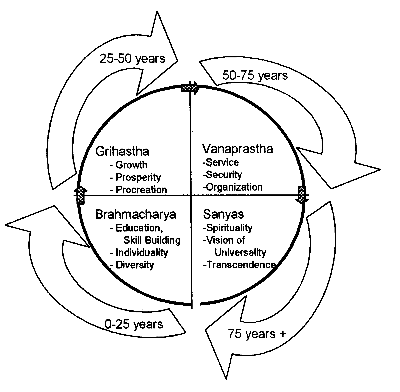Comments about the book by Copthorne Macdonald
IN
OUR OWN IMAGE:
Humanity's Quest for Divinity via Technology
by Debashis Chowdhury
Published
by Author House 2006
Paperback. $13.95. ISBN: 978-1425942793
Also available from Amazon.com
The author grew up in India, and after receiving his Bachelors Degree in Communications and Electronics Engineering in that country he immigrated to the United States. In the US he pursued a Masters degree at Penn State, and since 1985 has worked for Intel in Arizona. IN OUR IMAGE is a thought-provoking book that has roots in Ashrama, the Indian philosophy that addresses the stages of human life. Chowdhury calls his expanded take on the subject Mahashrama — "extended (or Greater) Ashrama."|
The figure at the right illustrates Mahashrama as it applies to individuals. The human life cycle starts at the bottom of the figure and progresses clockwise through the four quadrants. Brahmacharya is the first of these, and here the author says, "Emphasis is on learning and proficiency in the skill set required for competitive self sufficiency. The 'Individuality" of the human being is also developed at this stage." In the next stage of life, Grihastha, "Emphasis is on discharging our Genetic Imperative (procreation) and Economic Imperative (providing for family, future activities.)" With those goals reached, the individual at mid life faces the "what next" issue. In the Vanaprastha stage that follows "Emphasis is on Community and Service leadership with the goal of growing spiritually to be able to relate to causes that are important to all humanity." |
 |
Sanyas is the final stage of Mahashrama. "Emphais is on spirituality with the goal of 'transcending' our human condition, and codifying the 'essence' or 'spirit' of what it means to be human for posterity. The person going through Sanyas is the 'sanyasi'."
It is clear to me that this schema applies to the progression of lives here in the West as well as lives in India. Some individuals may start their spiritual development earlier in life, some may go to the grave never having dealt with spiritual issues, and the timing of the stage-to-stage transitions is only suggestive, not cast in stone. But this map fits the general pattern of many lives. It also sheds light on philanthropy. When considering the lives of people who amassed great fortunes and then began to give those fortunes away — people such as Carnegie, Rockefeller, and Bill Gates — a common thought is that they turned to philanthropy out of guilt. The Mahashrama model, however, paints this broadening of concern and turning away from acquisition as a natural, to-be-expected, part of life.
Chowdhury starts with the personal, but then explores the application of the Mahashrama Cycle to corporations, to governance, and to how the model could be helpful in, as he puts it, "ensuring humankind's survival and prosperity." He proposes many activities, but identifies as Job #1 "establishing the Vanaprastha Network." He calls on people who have reached the Vanasprastha stage of life "to mobilize the potential that is latent within us humans." He says that "a way needs to be found for the vanasprasthi to reach far and wide — and be able to enroll every individual [young and old] who would want to be reached into the overall purpose of existence." Assuming this network is successful in keeping humanity from destroying civilized living, Chowdhury sees other projects for humanity in the coming centuries, some of which involve the tight integration of technology and human life. Among these are the preservation of cultural wisdom from generation to generation, immersive virtual presence, and weaving together human and computer intelligences more effectively.
I found the ideas that Chowdhury presents to be highly stimulating. I didn't resonate with every detail of his vision, but I feel that this book is a valuable read for those of us who are concerned with the development of greater individual and societal wisdom..